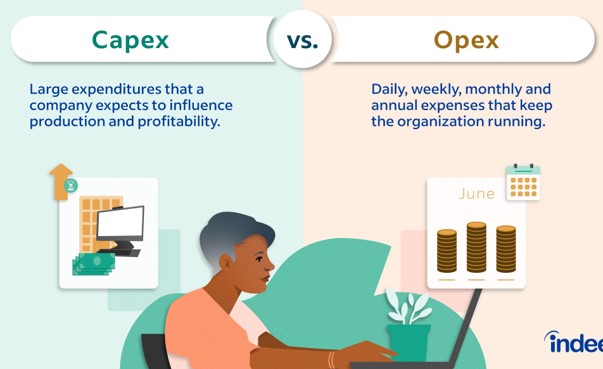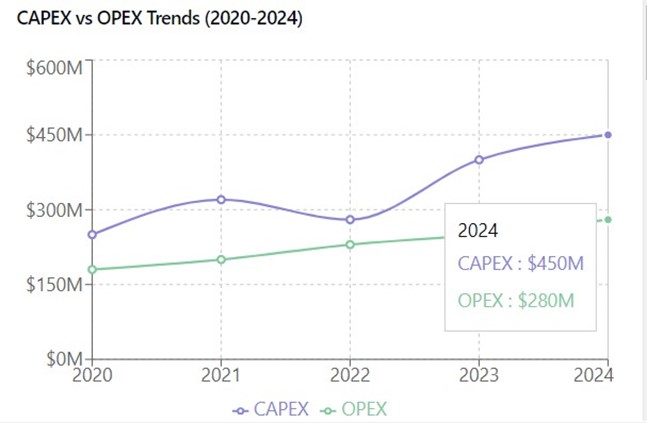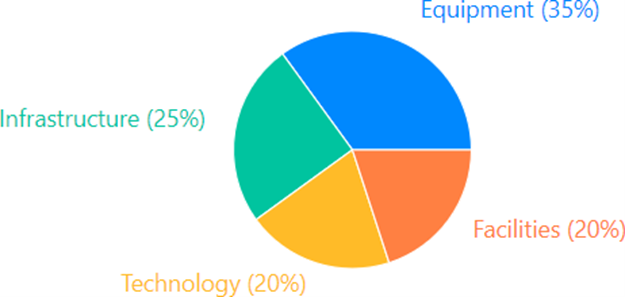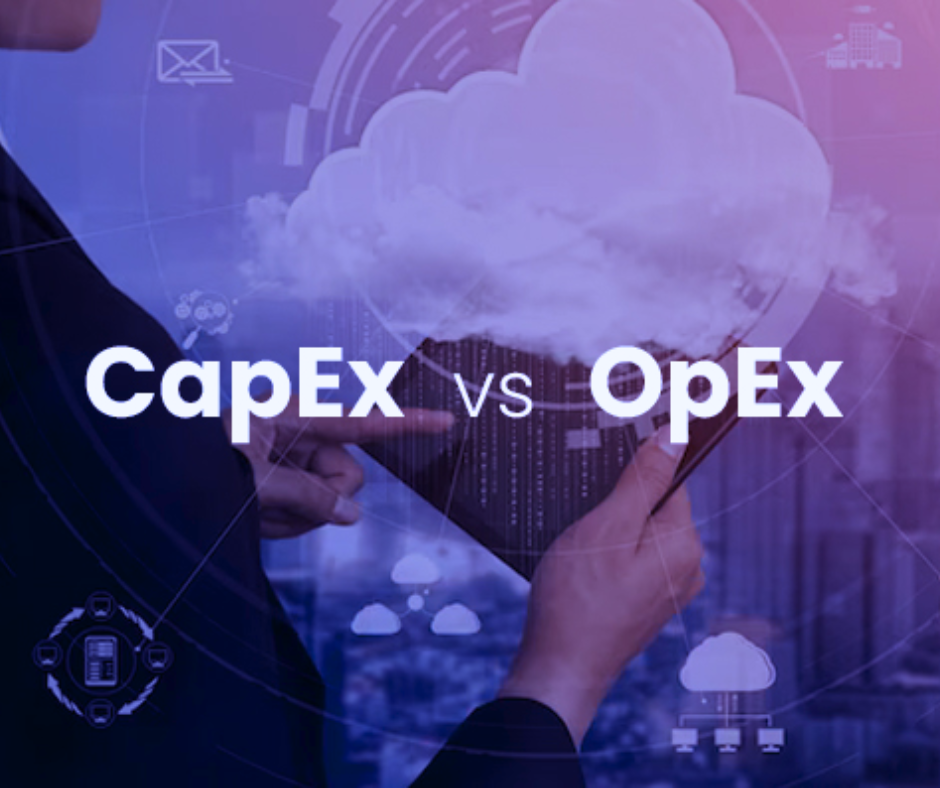Prologue
- Capex requires high upfront costs for long-term assets, while Opex spreads smaller, ongoing expenses, offering greater flexibility for scalability.
- Capex expenses are depreciated over time, whereas Opex is fully deductible in the year incurred, improving short-term cash flow.
- By 2024, 94% of enterprises adopted Opex-focused cloud services, driving the global cloud market to a projected $1.2 trillion by 2030. Capex suits stable, long-term growth plans, while Opex minimizes risk and enables rapid adaptation in fast-changing industries.
Introduction
Businesses face critical financial decisions when determining how to allocate resources for growth. Two primary funding models—Capital Expenditure (Capex) and Operating Expenditure (Opex)—each come with distinct advantages, challenges, and implications for an organization’s financial health and strategic goals. This report delves into the key differences, advantages, disadvantages, and decision-making frameworks to help businesses choose the right funding model.
Understanding Capex and Opex
- Capital Expenditure (Capex): Capex refers to the funds a company uses to acquire, upgrade, or maintain physical assets such as property, plant, equipment, or technology infrastructure. These expenses are typically one-time, significant investments that are recorded as assets on the balance sheet and depreciated over time. Examples include purchasing machinery, building facilities, or implementing new software systems.
- Operating Expenditure (Opex): Opex refers to the ongoing costs a business incurs as part of its regular operations, such as salaries, utilities, rent, and raw materials. These expenses are necessary for day-to- day activities and are fully deductible in the year they are incurred, helping to reduce taxable income. Unlike capital expenditures, Opex does not involve the purchase of long-term assets but focuses on maintaining business functions and services.

Advantages of Capital Expenditure (Capex):
Long-Term Investment:
Capital expenditures are typically made with long-term goals in mind. By investing in assets like machinery, property, or technology, companies are able to boost their production capacity, enhance efficiency, and stay competitive in the market. This long-term investment supports sustained business growth and profitability over time.
Asset Ownership:
Unlike operational expenditures (Opex), which involve recurring costs, Capex allows a company to acquire assets that it owns. This ownership adds value to the business and can improve its balance sheet. These assets can also be depreciated over time, providing potential tax benefits.
Increased Operational Efficiency:
Capital investments often lead to the implementation of advanced systems or equipment that can increase productivity, reduce costs, and streamline operations. This can lead to higher profit margins, improved quality of goods or services, and better customer satisfaction.
Asset Appreciation:
In some cases, capital expenditures on property or equipment can appreciate in value over time. For example, land and buildings can increase in value due to market conditions. This appreciation adds to the overall value of the business and can be realized if the asset is sold in the future.
Depreciation Benefits:
The depreciation of capital assets over time provides tax relief. Businesses can spread the cost of assets across their useful life, reducing taxable income annually. This allows companies to save money on taxes in the long term and reinvest the savings back into operations.
Disadvantages of Capital Expenditure (Capex):
High Initial Costs:
One of the major drawbacks of Capex is the significant upfront investment required. Large purchases such as machinery, buildings, or vehicles demand substantial capital outlays, which can strain a company’s finances. This may lead to borrowing or diverting funds from other areas, causing potential liquidity issues.
Long Payback Period:
The return on investment (ROI) for capital expenditures may take a long time to materialize. Unlike operational expenses that can provide immediate benefits, Capex often requires a lengthy period before the business sees returns, which may delay profitability and affect cash flow in the short term.
Obsolescence Risk:
Investments in technology or machinery come with the risk of obsolescence. As industries evolve and new technologies emerge, previously purchased assets may become outdated or less effective, forcing companies to invest in upgrades or replacements sooner than anticipated.
Maintenance and Upkeep Costs:
While Capex helps in acquiring assets, it also involves ongoing maintenance and operational costs. Machinery, buildings, and equipment require regular maintenance, repairs, and upgrades, which can become costly over time. These costs may offset some of the benefits, especially if the assets are not efficiently managed.
Impact on Cash Flow:
Since capital expenditures require significant upfront investment, they can have an adverse effect on a company’s cash flow. High capital investments may reduce available cash for day-to-day operations, limiting a business’s flexibility and ability to respond to unforeseen circumstances or opportunities.
Advantages of Operating Expenditure (Opex):
Flexible and Short-Term:
One of the key benefits of operational expenditure is its short-term nature. Unlike capital expenditure (Capex), Opex covers day-to-day costs that can be adjusted quickly based on business needs. This provides companies with flexibility in managing their expenses, allowing them to adapt to changing market conditions or business priorities without long-term financial commitments.
Lower Upfront Costs:
Opex generally involves lower upfront costs compared to Capex, as it includes recurring expenses such as salaries, rent, utilities, and office supplies. This allows businesses, particularly startups or small companies, to manage their cash flow more effectively and avoid taking on substantial debt or capital investment.
Tax Benefits:
Operating expenses are fully deductible in the year they are incurred, which can reduce a company’s taxable income. This offers immediate tax savings, making Opex an attractive way to manage financial resources and lower tax liabilities compared to capital expenditures, which are depreciated over time.
No Long-Term Commitment:
Opex does not involve the long-term financial commitment associated with Capex. Since operational expenditures are incurred as part of the regular business cycle, they can be adjusted, scaled, or eliminated as needed. This provides more operational agility, especially in industries that face fluctuating demand or economic uncertainty.
Easier to Budget and Forecast:
Since Opex typically involves predictable, recurring expenses, it is easier for companies to budget and forecast. Businesses can anticipate their operational costs and plan accordingly, ensuring that they maintain sufficient cash flow to cover essential expenses without unexpected financial strain.
Disadvantages of Operating Expenditure (Opex):
Limited Long-Term Benefits:
Unlike Capex, which can contribute to long-term business growth by acquiring assets, Opex covers only the day-to-day operational needs. While Opex is necessary for maintaining business functions, it does not directly contribute to expanding the company’s assets or its ability to scale in the future.
Ongoing Recurring Costs:
Operating expenses are recurring in nature, meaning they must be paid continuously. Over time, these costs can accumulate and significantly impact profitability, especially if not managed effectively. In contrast, capital expenditures often involve one-time costs that lead to long-term returns.
No Asset Ownership:
When a company incurs operational expenses, it doesn’t acquire any ownership of assets. For instance, renting office space or outsourcing services may be necessary but doesn’t result in the company building any equity or owning property. This may hinder long-term wealth generation and asset accumulation for the business.
Impact on Profitability:
Since Opex directly affects the bottom line, high operational expenses can reduce profitability. If a business cannot effectively control its operating costs, it may struggle to maintain healthy profit margins, especially in industries with low margins or intense competition.
Potential for Over-Reliance:
Businesses that overly rely on Opex may face challenges if unexpected costs arise or if the market environment changes. While flexibility is an advantage, it can also lead to an inefficient allocation of resources if not carefully managed.
Capex vs Opex Analysis
An analysis of Capex (Capital Expenditures) and Opex (Operational Expenditures) focuses on how these expenditures impact a business’s financial health, operational efficiency, and strategic decisions.

The data shows a consistent upward trend in both CAPEX and OPEX from 2020 to 2024, with CAPEX growing at a faster rate (80% increase) compared to OPEX (55% increase). The most significant CAPEX jump occurred between 2022 and 2023, indicating major infrastructure investments.
The OPEX growth rate has remained relatively stable, increasing by approximately $25M annually. This suggests effective cost management despite business expansion. The CAPEX-to-OPEX ratio has increased from 1.39 in 2020 to 1.61 in 2024, indicating growing capital intensity.
CAPEX Breakdown by Category

Equipment and Infrastructure combined account for 60% of CAPEX allocation, suggesting a strong focus on physical asset development. Technology investments represent 20% of CAPEX, reflecting digital transformation initiatives.
The increasing CAPEX trend suggests a growth-oriented strategy with significant investments in long-term assets. The balanced distribution across categories indicates a diversified approach to capital allocation, reducing concentration risk.
Factors to Consider When Choosing Capex or Opex
When deciding between Capital Expenditure (Capex) and Operational Expenditure (Opex), there are several key factors to consider:
Financial Impact and Cash Flow:
- Capex involves significant upfront costs for assets like machinery, property, or equipment, which can impact short-term cash flow. However, Capex may result in long-term savings and asset appreciation. Opex, on the other hand, involves ongoing expenses for day-to-day operations, which can be easier to manage within existing budgets. Choosing between Capex and Opex depends on your company’s current financial position and long-term financial strategy.
Tax Implications:
- Capex typically involves depreciation, which may offer tax benefits over time as it can reduce taxable income. Opex costs, however, are typically fully deductible in the year they are incurred, providing immediate tax relief. The choice between Capex and Opex may depend on whether the organization is looking to optimize tax savings in the short-term or long-term.
Risk and Flexibility:
- Capex can be riskier because it requires a significant investment upfront with long-term commitments. If the asset becomes obsolete or less efficient, the company may struggle to recover the investment. Opex, in contrast, allows for more flexibility. Since costs are spread over time, it enables a company to adapt more quickly to changes in technology or business needs, mitigating risk.
Asset Life Cycle and Depreciation:
- Capex typically involves assets with a longer life cycle, such as buildings, machinery, or vehicles. These assets appreciate or depreciate over time, and Capex takes into account the asset’s expected useful life. Opex is used for short-term, operational costs and doesn’t directly impact asset value or life cycle. It’s important to assess how long you intend to use the asset and whether it’s likely to need replacement or maintenance.
The decision to choose Capex or Opex depends on various financial, operational, and strategic considerations. A company must evaluate its financial situation, long-term plans, flexibility needs, and the specific asset involved when making this decision.
Emerging Trends in Capex and Opex
- Shift Toward Cloud Computing and SaaS (Software as a Service): A key emerging trend is the increasing adoption of cloud-based solutions, where companies opt for Opex models through subscription-based services instead of large upfront investments in infrastructure. This allows businesses to pay for only what they use, reducing the financial risk of large capital investments.
- Technological Advancements and Automation: Automation and AI tools are increasingly shifting industries towards Opex models. Companies can lease or subscribe to automation software and hardware without the need to invest large amounts in purchasing these technologies outright. Capex might still be necessary for acquiring foundational technologies, but ongoing costs for updates, training, and support are often handled as Opex.
- Remote Work and Distributed Teams: The trend toward remote work has increased the reliance on cloud technologies and outsourced services, encouraging businesses to move away from heavy Capex on physical infrastructure like office buildings or hardware. Instead, companies are investing in Opex models, including cloud services, virtual collaboration tools, and third-party remote IT support.
- Sustainability and Green Initiatives: In industries focused on sustainability, companies are opting for Opex models to reduce the environmental impact of ownership. Rather than purchasing energy-intensive machinery or vehicles, businesses may lease equipment or use services that are more energy-efficient, aligning with green objectives.
Conclusion
Choosing between Capex and Opex depends on a company’s financial position, growth objectives, and operational needs. Capex is ideal for businesses seeking long-term investments in assets that can provide lasting value, tax advantages, and control. Opex, on the other hand, offers flexibility, lower upfront costs, and easier scalability, making it suitable for businesses that need to adapt quickly and optimize cash flow. The right model ultimately aligns with the company’s financial strategy, industry dynamics, and future goals.





